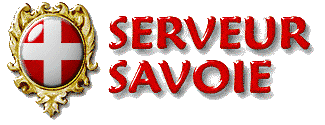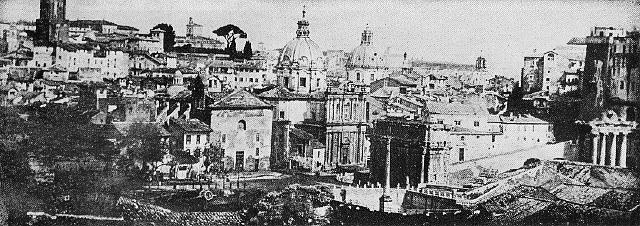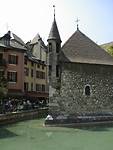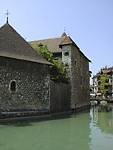PANORAMA-RAMA! (the panorama page)
[ HISTORY OF THE PANORAMA ] - [ WIDELUX ] - [ DIGITAL PANORAMAS ] - [ PROGRAMS ]
[ LINKS TO OTHER PANORAMA SITES ] - [ IPIX ]

Since the dawn of photography in 1839, photographers have tried to represent the world that they see. The human field of vision being wider than it is high, photographers began to assemble images horizontally in order to represent the entire scene laid out in front of them. A panorama can totally encircle the viewer, reaching a full 360º , while any image covering more than 100º may technically be called a panorama.
The very word "panorama" was coined by the Irish painter Robert Barker (1739-1806). Barker patented his invention, an enormous cirular painting which represented the city of Edinburgh. With showings of his painting in Glasgow and London, he made a fortune, prefiguring in a way the "IMAX" theaters of today. He hired assistants and sold licences in other countries. The Frenchman Pierre Prévost popularized the panorama on the Old Continent, and he is frequently cited as its inventor whereas he was merely the clever and successful holder of the patent in France. One of Prévost's assistants, the young landscape painter Louis-Jacques Mandé Daguerre (seen at right) made his fortune with a similar process, which he called the Diorama. Instead of being merely a large landscape painting, the Diorama was a painted representation of Napoleonic battles. Enormous paintings, painted on a sheer fabric, were illuminated in such a way as to convey action and movement in the battle scene. It was a kind of light & sound show long before electricity made such AV performances routine. Opening in 1822, the Diorama was an enormous commercial success: people went to see the Diorama in the same that their descendants now go to see Star Wars at the cinema! Panoramas at this time were extremely popular, and the suffix
"-rama" entered the language at that time. It can be found on countless words coined since then, and can even be seen in a famous French novel, Balzac's Père Goriot, in which the characters entertain themselves at dinner by coining new words with the then-fashionable new suffix.
It is with the money earned with his Diorama that Daguerre was able to retire and devote himself to the invention of photography, picking up where Nicéphore Niépce had left off. Niépce had created poor-quality images as early as 1822 using a bitumen of Judea emulsion, but exposure times exceeded ten hours and the process was never practical. After some fifteen years of additional experimentation, Daguerre elaborated a process in which a silver plate, exposed to iodine vapour, was used as "film". The image, after an exposure of just a few minutes, was "fixed" with sodium hyposulfite. Thus the invention of the silver-based emulsion, and the discovery of sodium hyposulfite (universal fixer) can be attributed to Daguerre. He made this process public in 1839 and gained world-wide reknown as the inventor of photography. It must be pointed out that other scientists were also working on similar processes at the time: among them an Englishman, William Henry Fox Talbot, and the Frenchman Hippolyte Bayard, who independently and simultaneously invented the concept of "negatives" and prints on paper, processes that they revealed to the world after Daguerre's invention had already been made public.
Panoramic photography developed right from the start of photography. the very first such images, made on broad silver plates, date back to this time. The image below, taken in 1842 by Girault de Prangey, represents Rome, as seen from the Palatine hill.
As early as 1846, special cameras were developed to allow the capture of extremely broad fields of view. To be called "panoramic" an image must exceed 100 degrees of width, a bit less than one-third of the total field that surrounds the viewer. In order to obtain such a broad view, certain designs use a lens that pivots from one side to the other, exposing film or a plate which must be held against a curved back so that the exposure is consistent. The Japanese Widelux and Russian Horizont cameras use pivoting lens design. Other high-performance cameras, such as the Hulcher or Globus, can take images that describe a complete circle around the viewer. The entire camera rotates on a pivot as the film moves through the camera at the same rate as the spin. The mechanics are complex, all parts must be made with great precision so that exposure is consistent through the entire frame. As a result, such cameras are quite expensive; an additional difficulty arises from the fact that very few photo labs are able to make prints from 35mm negatives or transparencies that may exceed 20cm ( 8 inches ) in length!
A Widelux camera was used to make the image below ( Talloires bay, on Lake Annecy ). The camera uses 35mm film and creates an exposure that measures 24x59mm, and which covers a field of 140º (measured diagonally across the frame). This image was used by the Talloires Tourist Office for a poster.
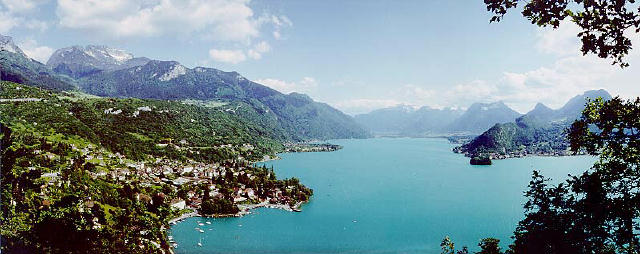
Since the invention of digital photography way back in the Nineties, it has become easier, and much more affordable, to use digital images and special software to create panoramas by stitching together a set of images.
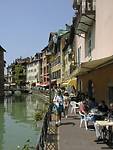
The three images above show the Palais de l'Isle in Annecy and were taken a few seconds apart. The light source is constant, and there is sufficient overlap from one image to the next for the software program to be able to stitch the three images together, averaging data from one frame to the next. However, it should be noted that the sky exposure, inconsistent because of the sun's position on the left side of the picture, resulted in an unattractive image. So the photographer, using PhotoShop, removed the entire sky and replaced it with a relatively even blue tint which serves as a backgroung in the whole image:
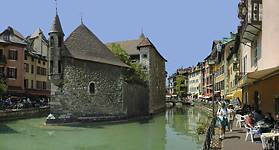
Much broader images can be made, provided that the camera is pivoted on the very axis of the lens (not of the tripod socket). Rotating the camera over the "nodal axis" of the lens allows the photographer to make undistorted images, such as the one below:

This panoramic view of the Mont Blanc mountain chain, taken from Plan Praz (Mt Brévent)
is composed of some eight different pictures stitched together. it covers about 180º .
Panorama-creation software is usually bundled in the software package included with digital cameras, so that theoretically anyone with a digicam can create panoramas. Each program offers a slightly different feature set, some allowing manual adjustment of inaccurate automatic stitching, some not... certain programs allow the export of panoramas to web pages, using either plug-ins or java applets. Some of these require some complex coding and as such are not particularly well suited for beginners. It should be noted that any digitized image, including scanned photos, may be stitched together to compose a panorama. However, all of the programs require images to be absolutely identical in pixel size, so that scanning of images may be more complicated than using digital cameras images. A very fine review of numerous stitching programs may be found on James Rigg's panorama software page. The two best programs for PC/Windows, in my view, are the two mentioned below:Live Picture PhotoVista ( www.livepicture.com ) has, since 1997, been one of the best panorama-creation software packages. It stitches images quite well, and seldom needs manual correction, which nonetheless is possible. The image of Annecy's Palais de l'Isle was made with PhotoVista.
PixMaker Lite ( www.pixaround.com )is a newcomer in the panorama software market, introduced in April 2000. Nonetheless this freeware is an outstanding performer. It stitches very accurately, gives the user manual control, and provides an excellent Java© applet to display the images in a dynamic mode. Nearly all panorama images on this entire website were created and posted using this software. The image below was assembled using PixMaker Lite and can be viewed scrolling through the entire panorama by clicking on the image below:
Enroute QuickStitch ( www.enroute.com ) is a different kind of panorama software: it allows the user to build high-resolution images by assembling a mosaic of up to 16 images ( laid out in a 4x4 grid ) to create a single, large image. More automatic than PhotoVista or PixMaker Lite, QuickStitch requires a very precise alignment of the images, with a great deal of overlap from picture to picture. There is no manual override of alignment, so that if a set of pictures does not assemble correctly, there are no other options. You have to reshoot the set of images. QuickStitch 360º is Enroute's circular panorama entry; it is not all that effective and allows no manual adjustment. Furthermore, the registration/activation process required by Enroute (as an anti-piracy measure) is an absolute pain to deal with; it takes upwards of fours hours to install the program. Not worth the trouble, especially with the excellent freeware now available from Pixaround!
The six images below were assembled with QuickStitch. The completed panorama can be seen just below the grid of six images.

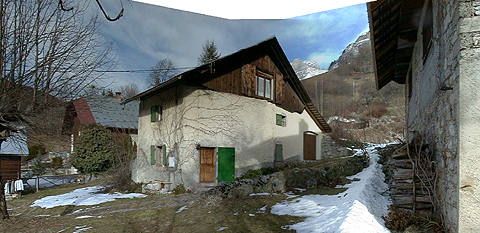
IPIX ( page ipix ) uses a new technololy and creates 360ºx360º panoramas: that is to say that the viewer is entirely surrounded by the image, as if in the middle of a visual bubble. The photographer takes two fisheye images that are then assembled automatically by the IPIX software. The specific equipment used must be calibrated for use with the program, or inaccurate stitches will result. IPIX offers a viewing experience that can not be duplicated with a print, and as such is restricted to viewing on a computer monitor.
The image below, the Prior's chamber in the Abbaye Hotel in Talloires (France) is an IPIX displayed by means of a JAVA applet. Smaller and less detailed than a high-resolution IPIX image, it has the advantage of not requiring the installation of a (free) plug-in. You can click on the image below to slect the view that you wish.
Other Web Sites about Panoramas
Panoramic Images of Savoie made with Pixaround.
Panoramic images of Faverges (74210) .
Panoramic images from other places .
Suspended Bridges of Haute Savoie stupendous images made with Pixaround.
Annecy-rama, Cyrille's site at Séquentiel : a virtual visit of Annecy, made up of panoramas linked together with hotspots. Annecy castle, the Palais de l'Isle, Town Hall, etc... that you can see by clicking on the link below:
Annecy-rama Open window
"Guide to Panoramas and Panoramic Photography"
James Rigg's excellent English-language site; techniques and programmes for the assembly of panoramic images. good illustrations, clear explanations.
Paul Fulbrook's site : Pan images made by en English friend. Images of the "pubs" of his town.
|
Thank
you for being visitor Nº
|
|
|

Page and images© 2000 by Robert
F. Jeantet
updated May 6 2000
updated May 6 2000
fin de la page Panorama-RAMA!

